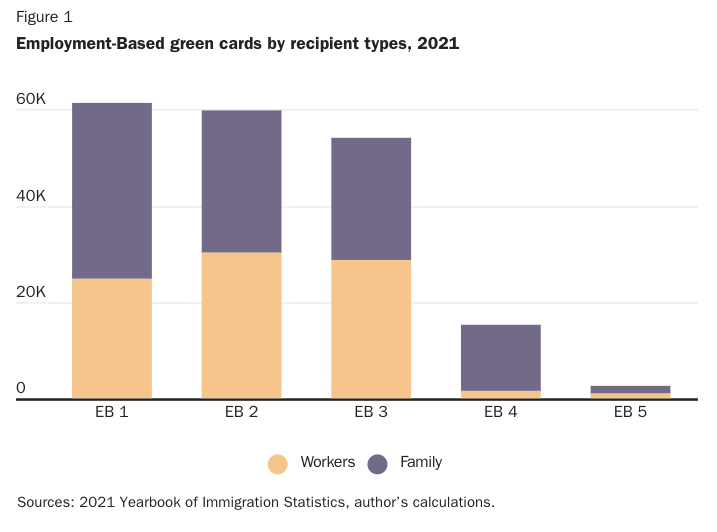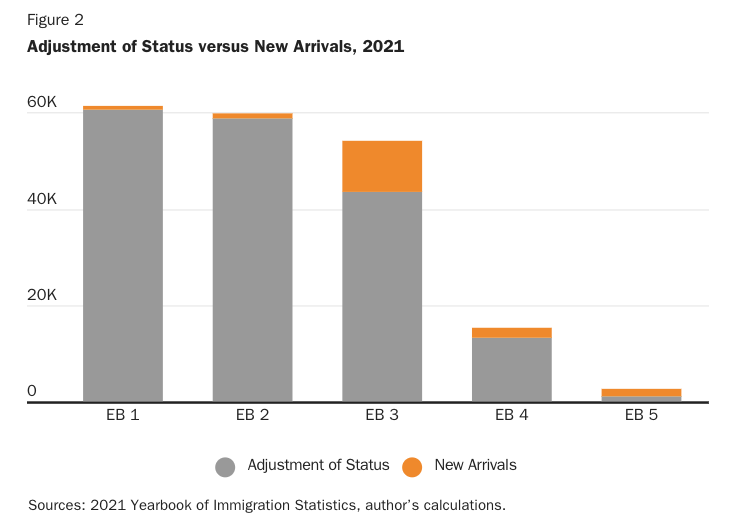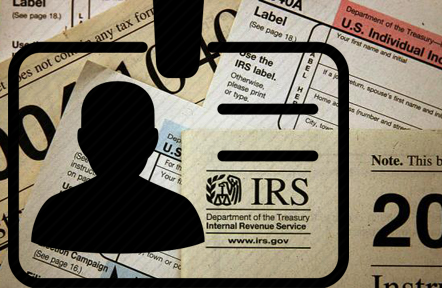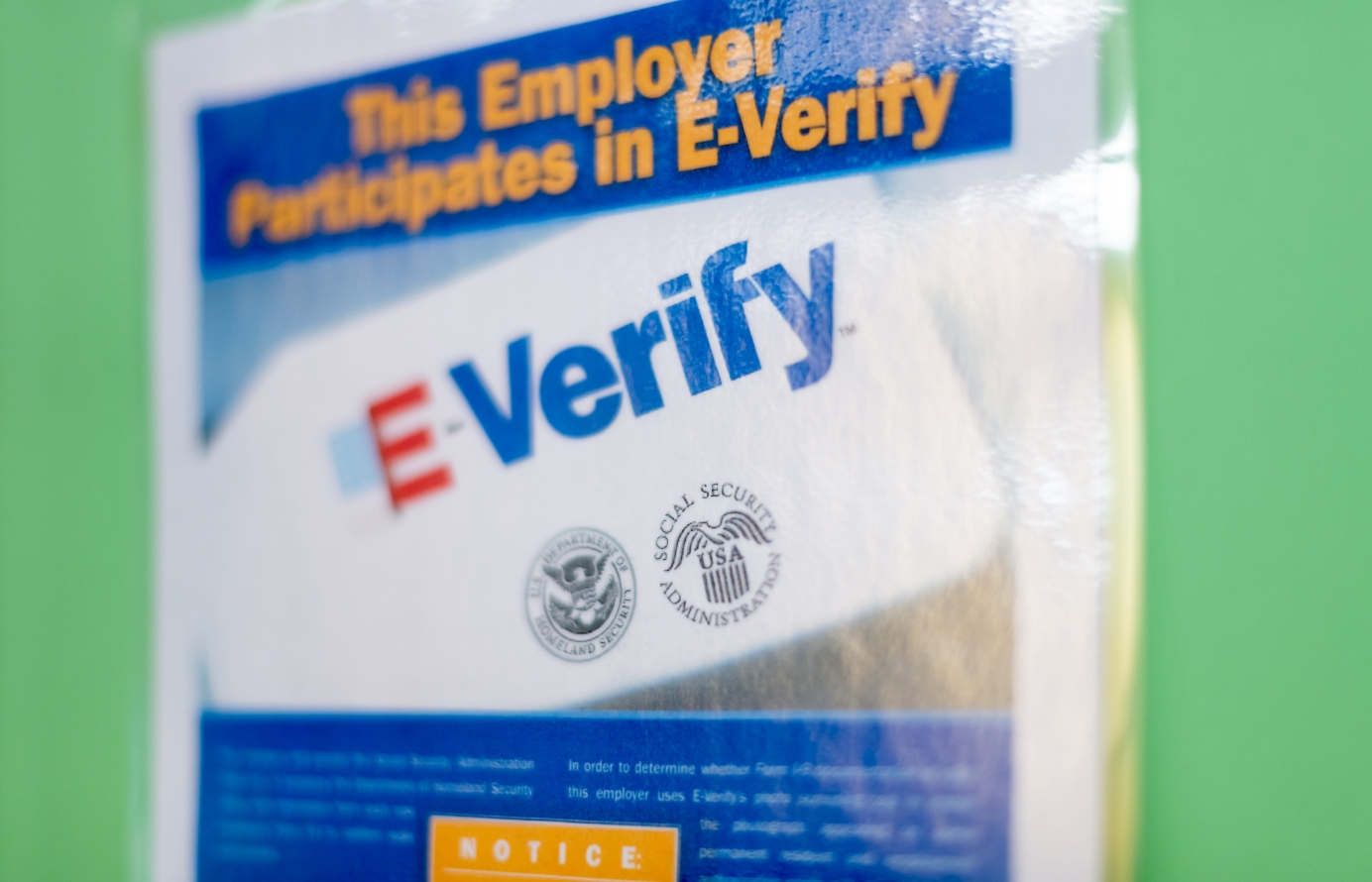Only 45 Percent of Employment‐Based Green Cards Went to Workers in 2021
The immigration system of the United States favors family reunification even in the so‐called employment‐based (EB) green card categories. Under current interpretations of U.S. immigration law, family members of immigrant workers must use EB green cards. The American system isn’t unusual as Japan is the only OECD country with more immigrant workers than immigrant family members. Still, the difference is larger in the United States than in other countries. Instead of a separate green card category for the spouses and children of workers, those family members get a green card that would otherwise have gone to a skilled worker.
In 2021, 55 percent of EB green cards went to the family members of workers (Figure 1). The workers themselves received the other 45 percent. Those percentages are similar to 2020, with the percentage of green card beneficiaries who are workers being slightly down. Some of those family members who received EB green cards are workers, and many of them are highly skilled since skilled people tend to marry each other, so this isn’t a neat de facto division.

Family‐based immigration is important for social, economic, and ethical reasons. Family‐based immigration is so essential that Congress should exempt family members from the EB green card cap altogether or, at least, create a new and separate green card category for themselves so that family members do not automatically reduce the number of workers by the same amount. If Congress exempted family members from the EB green card’s numerical cap or if there were a separate green card category for them, an additional 106,783 immigrant workers could have earned a green card in 2021 without increasing the numerical cap. That would have been a 123 percent increase without adjusting the cap number for that green card category.
Ninety‐two percent of those who received an EB green card in 2021, or 177,052, were already legally living in the United States (Figure 2). That’s up from 79 percent in 2019 but similar to 2020. Those who were already legally present and received their green cards were able to adjust their immigration status from another type of visa, like an H‑1B or an F visa, to an EB green card. Exempting those adjustments of status from the EB green card cap would boost the number of highly skilled workers who could have entered from abroad by a factor of 10.9, from a mere 16,247 up to the statutory cap.
Exempting adjustment of status from the EB green card cap would increase the number of green cards for the EB‑1 and EB‑2 categories. EB‑1 green cards are for workers of extraordinary ability, outstanding professors and researchers, and some multinational firm managers and executives. EB‑2 green cards are for professional workers with advanced degrees and those with exceptional ability in the sciences, arts, or business. In 2021, 99 percent of immigrants who received an EB‑1 and 98.8 percent of those who received an EB‑2 were adjustments of status. In other words, 24,550 EB‐1s adjusted their status and 259 came from abroad, while 30,048 EB‐2s adjusted their status and only 365 came from abroad. Workers on the EB‑1 and the EB‑2 are the most skilled, so increasing the numbers available to them would have the biggest positive economic effect while also increasing the number of green cards in other categories through trickle‐down.
Going forward, exempting adjustments of status from the EB green card cap would also empty the backlog imposed by the per‐country caps. Such a reform would especially benefit Indian workers on the H‑1B visa by shortening their absurd wait times without increasing the wait time for immigrants from other countries. Exempting adjustments of status, rather than tinkering with the numerical cap or getting rid of the per‐country caps, is the best policy for two reasons. First, the system would be more open and flexible. Second, it would avoid the debate over which arbitrary number should be the new EB green card cap. Congress should eliminate the per‐country cap, but exempting adjustments of status would achieve the same goal of reducing wait times for Indian immigrants without increasing them for others.

Here are some other exemption options for increasing the number of EB green cards issued annually without raising the overall numerical cap:
- Workers should be exempted from the EB green card cap if they have a higher level of education, like a graduate degree or a PhD.
- Workers should be exempted from the cap if they have a graduate degree or a PhD in particular fields such as science, technology, engineering, mathematics, or medicine. The House version of the America COMPETES Act did this in 2022.
- Some workers who adjust their status should be exempted from the numerical cap in the way the H‑1B visa exempts 20,000 graduates of American universities from that visa’s numerical cap. Exempting all workers who earned their degrees at U.S. universities is a good start.
- Immigrants who adjust their status should be exempt from the numerical cap because they have already proved their value to the American economy.
- Immigrants who adjust their status in the EB‑1 and EB‑2 categories should be exempted from the numerical cap.
- Workers should be exempted if they show five or more years of legal employment in the United States prior to obtaining their green card.
- Workers should be exempted based on the occupation they intend to enter. This is a problem because it requires the government to choose which occupations are deserving, but the benefits will outweigh the costs so long as it leads to a general increase in the potential numbers of skilled immigrant workers without decreasing them elsewhere.
- Workers should be exempted from the cap if they have waited for five years and are otherwise eligible for a green card.
- Workers should be exempted from the cap if they work in a non‐profit research institution or a university, similar to how they are exempted from the H‑1B visa cap.
- Workers should be exempted for other national security or geopolitical reasons if they are from countries that the U.S. government believes are a national security threat to the United States. For instance, exempting skilled workers from China, Russia, or Iran would reduce the number of skilled workers who could work in their defense industries.
- The United States should also exempt all EB green cards issued to Canadians and Mexicans because of the deep economic, social, and political ties between those countries.








